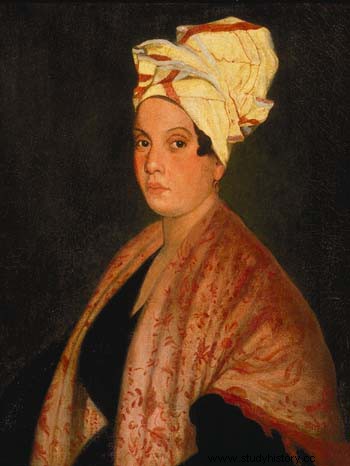The “Queen of Voodoo”, Marie Laveau (1801 – 1881), officiated in New Orleans at 19 e century; she is known as one of the most famous priestesses in the history of voodoo.
Born free in a slave state

Born free in New Orleans, Louisiana on September 10, 1801, Marie Laveau was the daughter of Marguerite Henry (or Marguerite D'Arcantel), a freed black woman, and Charles Laveau, a politician of French descent; his father, who is married to a woman named Charlotte Perrault with whom he has four daughters, will become the city's fifth mayor.
At the time of Marie's birth, Louisiana briefly became French again after forty years under Spanish control; two years later, it was sold by Napoleon to the young United States, which proclaimed its independence less than thirty years ago. New Orleans was then the dynamic capital of a state that was among those with the largest number of slaves; in 1830, there were 42,000 slaves in Louisiana, or 13% of the population. The cultivation of sugar cane, which is extremely difficult, is very widespread in the many plantations.
Young widow then “placed”
In August 1819, Marie Laveau married Jacques Paris, a Creole originally from Haiti, who had come to settle in Louisiana with the wave of immigration following the Haitian Revolution of 1804. He worked as a carpenter in the French Vieux Carré, the historic center of New Orleans. The couple will have two daughters:Felicite, who was born two years before the wedding, and Angele in 1820; records lose track of the two girls in the 1820s.
Jacques Paris dies the year after the wedding, and Marie is for a time called the widow Paris. Having become a hairdresser at home with white families, the young woman moved in with a white Creole of French descent, Christophe Louis Duminy de Glapion, according to the system recognized in Louisiana society of “placing“, concubinage between a black or mixed-race woman. and a white man. Birth and baptismal records indicate that the couple will have seven children, of whom only two daughters, Marie Euchariste Eloise Laveau and Marie Philomene Glapion, will survive to adulthood.
The Voodoo Queen
After the death of her mother, Marie Laveau becomes a voodoo priestess and practices occultism, herbalism, healing, divination. A religion originating in the kingdom of Dahomey, in West Africa, voodoo spread widely in Louisiana through African slaves. Clandestine because prohibited by the colonists, it evolved in contact with European rules, Christianity, and under the yoke of slavery. Reinforced by the arrival of a wave of Haitian immigration after the revolution of 1804, voodoo is very important in New Orleans.
Reputed to be the granddaughter of an influential voodoo priestess in Santo Domingo, Marie is considered a great mambo and nicknamed "the queen of voodoo". She organizes secret ceremonies within her own home, in her garden where she summons the spirit of the deity Zombi who manifests in the form of a snake, but also in Congo Square, a public place, and at the confluence Bayou Saint-Jean and Lake Pontchartrain; it is where the most important ceremonies take place, including songs, dances, music and, say the stories, spiritual possessions.
Marie is respected and renowned even beyond Louisiana; we seek his advice and call on his powers of divination for problems related to marriage, marital disputes, motherhood, legal cases or even finances and health. Beyond the ceremonies, Mary also provides advice or talismans, aimed at protecting against misfortune or bringing good luck.
Marie Laveau died in June 1881, at the age of 79; she is buried in New Orleans. Shortly after, rumors say that people would have seen her in town. Mythical character strongly linked to the history of voodoo in New Orleans, Marie Laveau inspires many artists, songs, works of fiction.
